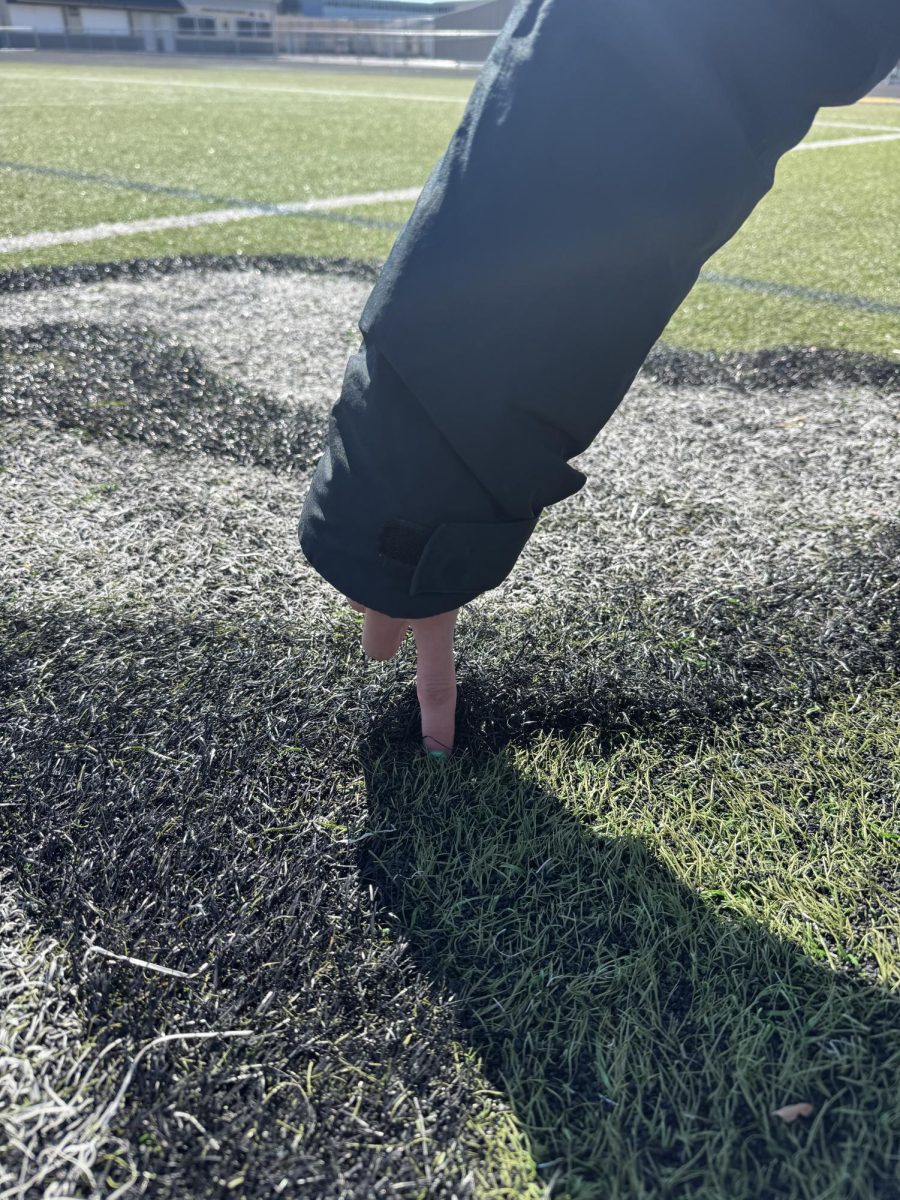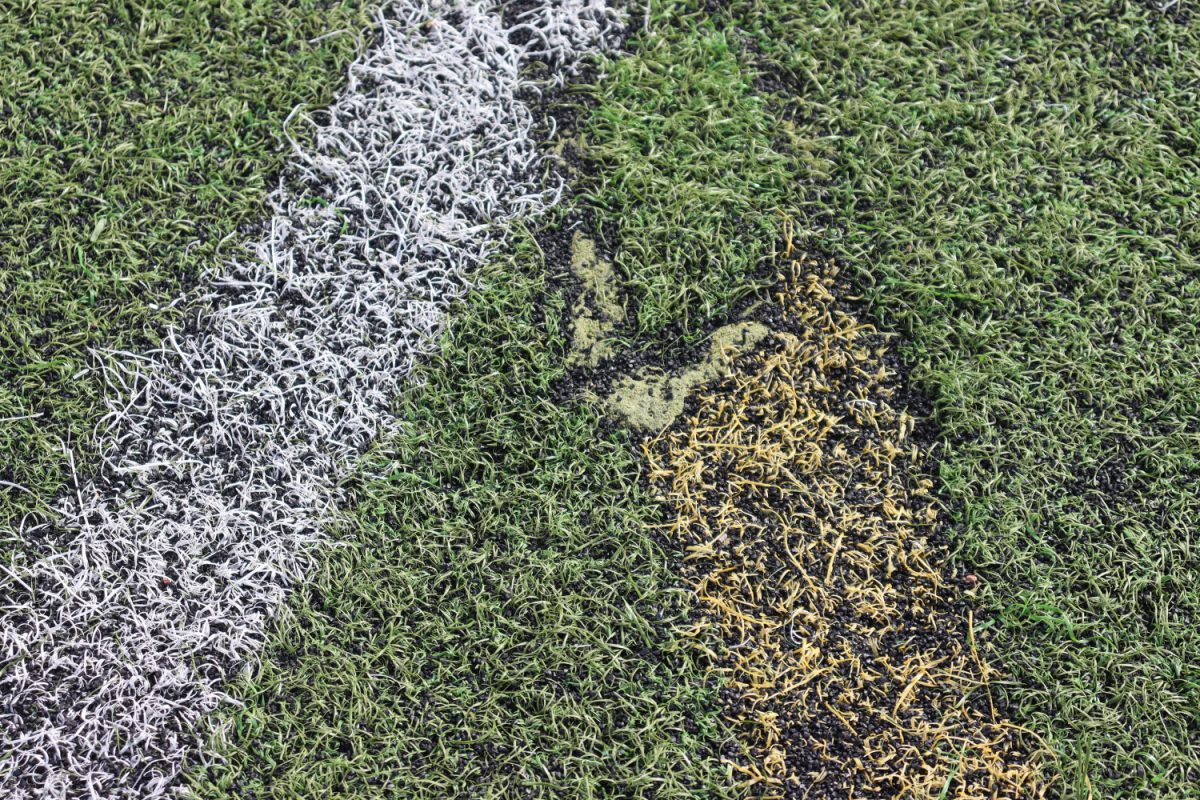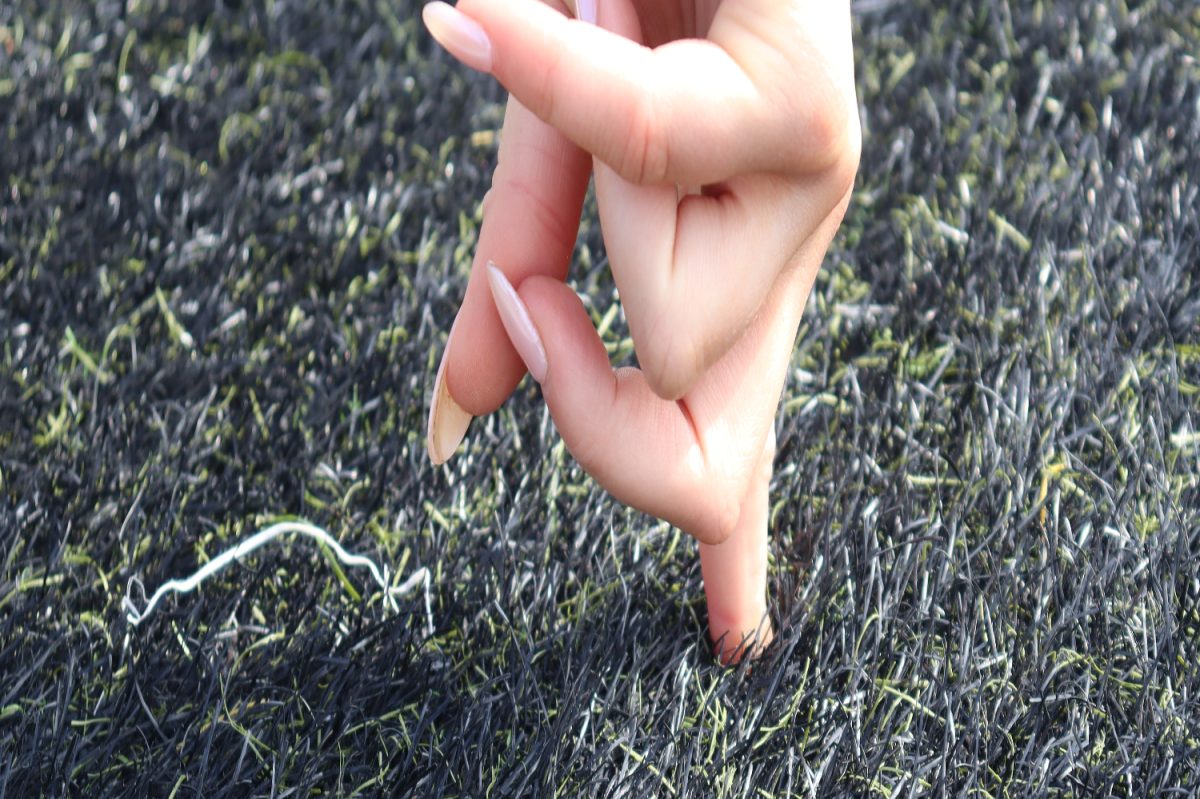Safety concerns rise as turf field deteriorates
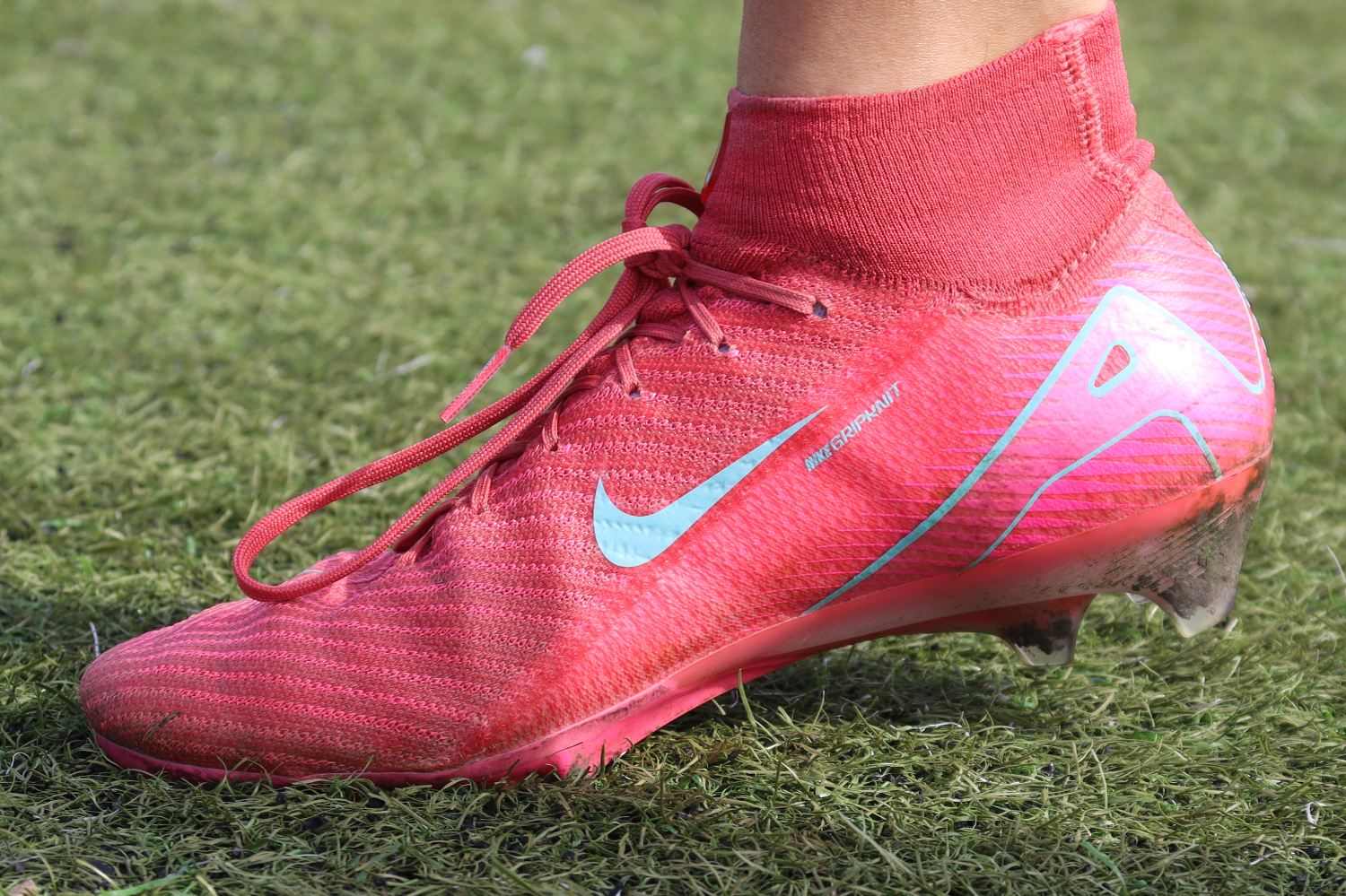
“I was running down the left sideline and planted my foot to cut inside, and my knee popped,” senior quarterback Jake MacLeod said. “My teammate did the same thing a week before, right around the same spot on the field.”
MacLeod tore his anterior cruciate ligament on the first play of the 2024 fall season, ending his campaign before it had barely begun. It was a non-contact injury. MacLeod believes the turf is outdated and not in good shape, visibly worse than the fields at other schools.
Metea’s current synthetic turf field was installed in 2009 and remains the original turf in the building. According to FieldTurf, artificial turf fields have a life expectancy of 8-10 years to ensure proper performance and safety. Metea’s turf is now 16 years old.
Metea coaches are concerned that the wear and tear could risk athletes’ physical health. Prolonging the life of the already deteriorated turf can be hazardous.
“When we go back and look at the data from each year, the majority of our injuries took place on the turf,” former head coach of Metea Valley football John Parpet said. “Over my 6 years, I think all of our significant injuries, whether that’s a coincidence or not, took place here.”
Despite football games being played in the stadium, Parpet noticed a significant difference in athletes’ physical health when using the grass fields for practice compared to the turf.
“Kids were fresher when we were on the grass because the turf was a main contributor to shin splints, a prevalent issue for a lot of our players,” Parpet explained. “We tried not doing anything with a lot of physicality when we practiced on the turf. We didn’t want them falling, hitting their head on the turf, because it was pretty hard.”
Long-term usage and flaws in field construction can result in poor quality, which negatively influences activities and the safety of athletes, according to UC Agriculture and Natural Resources. Student athletes such as MacLeod have expressed safety concerns as well as a noticeable difference in field quality compared to neighboring competitors, Naperville Central and Naperville North, which both have high-quality, maintained turf fields.
“I do not think [Metea’s field] is safe to play on compared to the other fields we have in our area,” MacLeod said. “You can tell it is not up to speed with the newer turfs as it’s not even completely level. There are many different spots with bumps and parts of the turf higher than other parts.”
Ethan Arbetman, junior defender for the boys’ varsity soccer team, expressed similar concerns and viewpoints. Arbetman experienced a broken collarbone when he got his foot caught in a bump on the turf as he went for a ball. He fell over awkwardly on his shoulder, resulting in a devastating injury.
“I do not think the turf is safe to play on, and I am concerned for anyone who plays on it,” Arbetman said. “The current condition of the turf isn’t great, and athletes who use the turf every day should not be on it.”
Metea Valley Athletic Director Matt Fehrmann sees areas on the field where some of the fibers are raised approximately a quarter-inch to a half-inch higher than the other areas.
“It’s uneven,” Fehrmann said. “It’s definitely something that is well past due to be replaced.”
Parpet attributes the uneven field continuation to the heavy amount of use.
“When we have the wear and tear of it, on top of all the different levels using it, it’s used pretty much every season except winter,” Parpet said. “Even then, you have to consider the winters out here, which are horrible.”
The visible condition of the turf raises concerns for individuals like Fehrmann, who question how it can be considered safe for student-athletes, as many compete on it almost daily.
In addition to the uneven fibers on the field, coaches and players have expressed concern over how hard the turf is, which could increase the risk of concussions and shin splints.
Synthetic turf hardness is measured with a GMAX test, which determines the impact attenuation, or the shock-absorbing strength of the surface. Utilizing a 20-lb, flat-ended missile that simulates an athlete’s impact with the surface, a GMAX test can identify the hardness of the synthetic turf to determine the safety for the athletes. The lower the GMAX reading, the more energy the surface absorbs. In contrast, the higher the GMAX reading, the less energy absorbed by the surface.
Ideally, a GMAX threshold between 90 and 115 is preferred, the number representing the shock absorption of high-quality natural grass. However, any score under 165 is considered acceptable by the Synthetic Turf Council (STC). The maximum limit, according to the ASTM International (F1936-10), is 200, suggesting that anything exceeding the limit can pose high risks for life-threatening injuries.
Metea regularly performs the GMAX test on the turf field. This past November, Metea had Tackett Sports Company FieldTurf issue a yearly GMAX test to measure the field’s softness. The tests came back with numbers between 165 and 175. These numbers are considered viable for a synthetic turf field installed in 2009.
“When these companies are coming out to do the GMAX test and say lines such as ‘it’s good’ or ‘you guys are in the range,’ I just question what we are missing,” Fehrmann said. “Appearance-wise and the missing fibers that we see on top all the time, just to me, something is missing, and it’s a piece I struggle with.”
In an email sent on November 12, 2024, and obtained by The Stampede through a Freedom of Information Act request, FieldTurf regional sales manager Brian Smykowski suggested that the district should continue performing yearly advanced care decompaction maintenance to help stand the synthetic fibers up and bring the infill back to level. With that process being continued yearly, he sees this field lasting till 2026.
“As discussed, we did not do the original install here,” Smykowski said in an email to Indian Prairie’s Director of Facility Operations, John Robinson. “Our goal is to help you extend the life here until it is financially viable for replacement.”
After FieldTurf applied the FieldCare solution and repaired the turf field in preparation for the winter season ahead, Robinson requested a further evaluation of the turf’s operational life.
“I need another 1.5 years out of this field, and I was under the impression from [FieldTurf] that that was attainable,” Robinson explained.
School board members have been asking the district about the process of replacing the turf at Metea since 2023. In September 2023, school board member Justin Karubas asked district administrators, “Where are we at with possibly getting artificial turf at WV/NV and replacing turf at MV?”
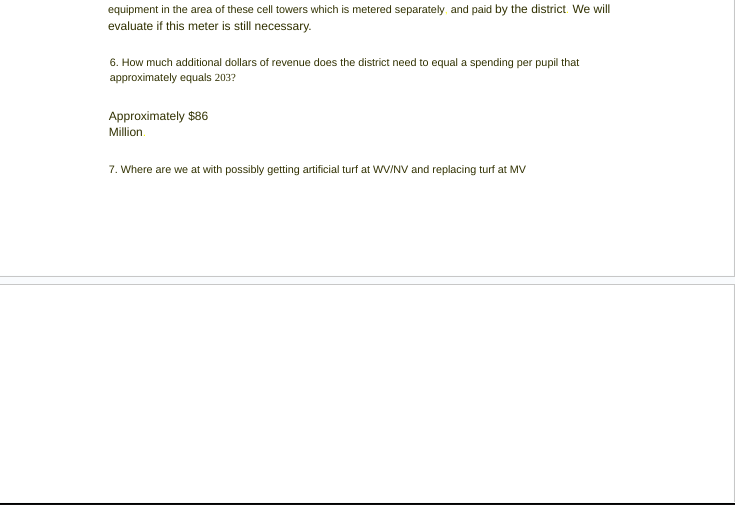
Indian Prairie Chief School Business Official Matt Shipley’s response was withheld from our Freedom of Information Act request, with the district citing “preliminary drafts, notes, recommendations, memoranda, and other records in which opinions are expressed or policies or actions are formulated.”
With the District 204 Bond referendum successfully passing last November, the district has goals to install new turf at all three high schools. Metea would undergo a turf replacement while Neuqua and Waubonsie would be a full build, site work, and turf installation. The undertaking of this multi-million-dollar plan would take place in 2026 at the earliest, before the 2027 school year, but it can change depending on other projects.
“We know it is a high priority for all three schools to get those fields so we want to get that work done as soon as possible,” Shipley said. “It is possible that the work at Waubonsie and Neuqua would occur during a part of a school year, and so what we are trying to finalize is those timelines and schedules to see how we can line them all up to be as efficient as possible.”
The estimated cost is between $1.5 million and $2 million for the turf replacement. The referendum package includes this funding
“We have to issue referendum bonds at the appropriate time to pay for the turf,” Shipley said. “We expect the next bond issue to be done in July, so then we will have the funds available to schedule the work accordingly.”
Shipley explained that this will be a fairly involved project.
“This type of construction project takes several months of planning, working with architects and engineers to develop plans to bid out the project, along with finding contractors to do the work,” Shipley said. “There is some significant work upfront that needs to be done before the actual project takes place. They expect to be starting on the planning process soon and then have a more specific timeline for the actual replacement by this summer or by the start of next school year.”
While FieldTurf estimates synthetic turf fields can last 8-10 years, Shipley believes the field could last for 10-12 years, which is still beyond Metea’s 16-year-old field.
“We did have a couple of years during Covid where the turf wasn’t being used as frequently, which has helped extend the useful life slightly,” Shipley said.
While the field saw reduced use during the pandemic, the turf is used just about every day during normal school years. Gym classes utilize the turf, in addition to sports teams and occasional renters.
“Having a turf field is kind of like a curse, because everybody wants to use it,” Fehrmann said. “Everybody thinks it’s not hard to manage it, but we have to have level-headed people to understand that other teams are just as important as they are.”
Metea competes in the DuPage Valley Conference, a high school athletic conference in the western suburbs of Chicago, primarily within DuPage County. The conference is known for its competitive nature and high level of play. To compete at the highest level, quality field conditions are critical.
Even with the Bond referendum listing new turf at all three high schools, district-wide urgency is absent, and uncertainty remains about a clear timeline for the turf installation at Metea. Shipley expressed earlier in an interview that the turf replacement would most likely take place in the summer of 2026 or early 2027, but then later stated that the plans are to replace it within the next couple of years.
“There is no question that it’s nearing the end of its useful life, but it does still have a few more years left and is still a safe surface for student athletes,” Shipley said.
As District 204 waits for the referendum bonds to process in order to have the funds for this large-scale project, there seems to be a disconnect between what is considered a “safe” surface for student-athletes to compete on.
“I hear it from coaches, almost weekly,” Fehrmann states. “This is not right.”





